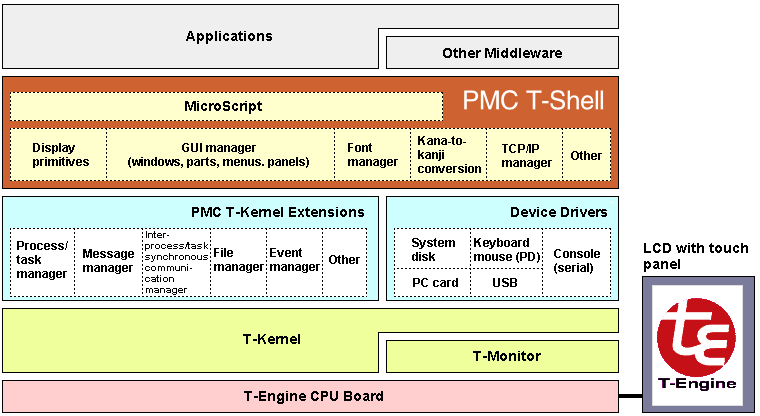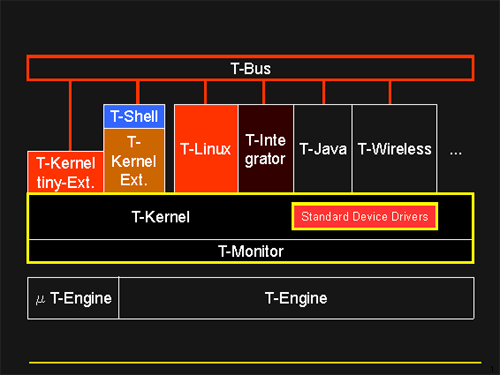

Personal Media Corporation announced on March 11 that it had successfully developed a multilingual graphical user interface (GUI) middleware development kit for T-Engine, which it would begin marketing for three types of T-Engine CPU boards from March 28. The new development kit, "PMC T-Shell Development Kit," consists of PMC T-Shell, which also includes the powerful MicroScript visual programming language that allows for the quick building of interfaces and applications, plus PMC T-Kernel Extensions and device drivers. The company said PMC T-Shell Development Kit will be sold via direct sales at 98,000 yen (consumption tax and final product licensing fees not included) for the T-Engine/SH7727, T-Engine/VR5500, T-Engine/ARM720-S1C T-Engine CPU boards. MicroScript programs written on any of one of these CPU boards can be ported to the others without recompiling, since the MicroScript language is an interpreted language that employs intermediate compilation.

As can be seen in the above illustration, the PMC T-Shell Development Kit is really a simplified version of the multilingual BTRON3-specification Cho Kanji 4 operating system, which has the largest character set of any personal computer operating system on the market and can even handle the Braille characters used by the visually disabled. Like the regular version of Cho Kanji 4, it includes graphic and character processing functions that allow developers to quickly and easily create GUI software parts (click here to see an example of a home lighting control panel switch). Personal Media envisions that the PMC T-Shell Development Kit will be used by developers of embedded systems that need create middleware with a highly functional GUIs, such as those required in audiovisual equipment, office automation equipment, vending machines, and kiosk terminals. Other applications envisioned by Personal Media are electronic books and dictionaries, plus terminals for use in electronic government.
Personal Media Corporation announced on March 11 that it would begin marketing an IPv6-compatible TCP/IP stack for T-Engine on March 31. The new TCP/IP stack, "KASAGO for T-Engine," will be marketed via direct sales at a price of 150,000 yen (consumption tax not included) for the T-Engine/SH7727, µT-Engine/M32104, and T-Engine/VR5500 development kits, which are likewise sold via direct marketing by Personal Media. The company said that KASAGO for T-Engine is compatible with "T-Format," which is the standard distribution format for middleware that runs on development boards based on the T-Engine specification. In addition, Personal Media said it is easy to customize KASAGO for T-Engine, and that there are a lot of options for it, such as IPsec (IP Security Protocol) and H.323 (a teleconferencing protocol).
KASAGO for T-Engine is actually a dual stack (compatible with both IPv4 and IPv6) based on "KASAGO IPv6," a TCP/IP stack developed by Elmic Systems Inc. in December 2002 that is capable of running on other types of real-time operating systems, such as ITRON. This dual stack feature allows it the flexibility to be made highly compatible with existing real-time systems. Moreover, since it was designed and developed from the start with embedded systems in mind, it is compact, fast, and highly reliable. Personal Media said that by porting KASAGO IPv6 to T-Engine, the time and cost required to create network information appliances and mobile devices can be dramatically improved. To underline that, the company said that there are many examples of its use over a wide range of applications, including cell-phones, network devices, and system chips. By porting KASAGO IPv6, it is expected that the popular TCP/IP stack will come into even wider use in the future.
The T-Engine Forum and MontaVista Software, Inc., announced on March 18 that MontaVista Linux, the version of the GNU/Linux operating system most widely used for real-time applications, " . . . has been selected as the preferred Linux platform defined in the T-Engine software architecture." According to T-Engine Forum sources, this move was taken because of demand from T-Engine corporate members, who want the popular version of the GNU/Linux operating system inside the T-Engine architecture. To accomplish that goal, a "T-Linux Working Group" is going to be established inside the T-Engine Forum in April. Once it is successfully ported to the T-Engine hardware platform, MontaVista Linux will be able to take advantage of unique features of the T-Engine architecture, such vastly higher real-time performance, the eTRON security architecture, and perhaps even the unique multilingual character processing system developed for the BTRON architecture (see the above story).

Since many foreign observers are interested in this topic (here's a sample), there are a couple of things to keep in mind. First, and foremost, is that the T-Engine specification is not going to be transformed into a GNU/Linux specification. At the last TRON show, the disadvantages of the GNU/Linux operating system were pointed out over and over again by various speakers in panel discussions. It is a workstation operating system based on time sharing multitasking that has a task switching time measured in milliseconds, not microseconds. Hence is is not suited to many of the tasks envisioned in the TRON Project, which calls for real-time multitasking in microseconds using a priority based task switching model. Second, inside the T-Engine architecture T-Linux will serve as an "environment for running middleware," i.e., an environment for running existing GNU/Linux applications. But at that level, it will be competing with other environments for running middleware, specifically T-Integrator and T-Java.
Interestingly, 10 days after the announcement by the T-Engine Forum and MontaVista Software, there was a Japanese language story at the Asahi Shimbun Web site (click here) that said the Ministry of Economy, Trade and Industry and Japanese electrical appliance makers had formed a committee to study how to unify standards for Net appliances by 2007. In the story, two operating systems, TRON and Linux, are mentioned as the basis for this unification of standards, since neither one of them is a closed, proprietary operating system. Of course, Microsoft Corporation and other personal computer makers in the U.S. are also interested in this field, especially because personal computer sales are slowing and profit margins are dropping. In the case of Microsoft, the company has developed Smart Personal Objects Technology to enter the Net appliance market, but it is very difficult to imagine the software giant succeeding in the embedded field, as the profit margins are very low.
On March 11, the T-Engine Forum announced that it had officially established the Ubiquitous ID Center, which currently has 52 corporate members referred to as "eKai-in," or eMembers. The goal of the Ubiquitous ID Center is to establish and spread the infrastructure technologies for automatically recognizing "things," thus allowing for the creation of ubiquitous computing environments. This has been a long standing goal of the TRON Project since it was officially launched in 1984, and Ubiquitous IDs (uIDs) are essential components for realizing them. These infrastructure technologies include not just the specifications of chips for radio frequency identification and/or contact/non-contact smart cards, but also those for reader devices plus a 128-bit identification numbering scheme, the numbers for which will be allotted by the Ubiquitous ID Center. Validation testing of the electronic IDs is scheduled to begin in April, the Ubiquitous ID Center said.
In addition, the T-Engine Forum announced that it has established three new working groups: the "Wireless T-Engine Working Group," the "RFID Working Group," and the "Scalable Vector Graphics Working Group." The Wireless T-Engine Working Group will draw up a "Wireless T-Engine" hardware specification, i.e., a standard T-Engine specification particularized for cell-phone use, plus "T-Wireless," a common API specification for next generation cell-phones. This standardization is necessary to reduce costs as cell-phones become more complex and gain more and more functionality. The Wireless T-Engine Working Group aims to realize a W-CDMA-based cell-phone based on T-Engine by the end of the year. Meanwhile, the RFID Working Group and the Scalable Vector Graphics Working Group respectively will work on the construction of systems for reading/writing RFIDs and the application of scalable vector graphics on T-Engine, e.g., an SVG browser.
Nikkei Business Publications' ITPro Web site reported on March 20 that the educational computer based on PIN CHANGE Co., Ltd's TEA Terminal will undergo validation testing during fiscal year 2003 in primary and middle schools in the Tokyo area. Renamed "eRandoseru," the T-Engine-based terminal is intended to supplement, not replace, traditional textbooks. In particular, the educational terminals are intended to enable students to gather information from the Internet and run educational materials developed for use on personal computers. The validation testing will mainly be conducted to see if several tens of the 802.11b-compatible wireless educational terminals can be operated simultaneously in a classroom environment. Since the terminals themselves are very cheap--the large screen model is 60,000 yen and the small screen model is 35,000 yen--they are expected to come into widespread use in the near future in Japan.